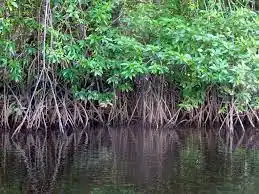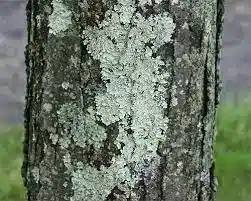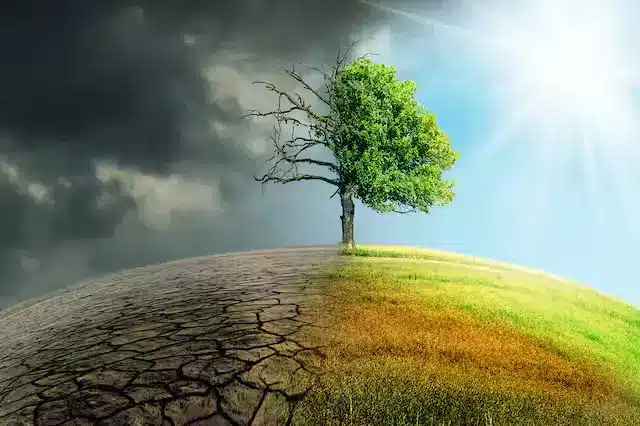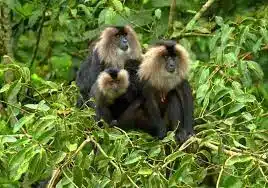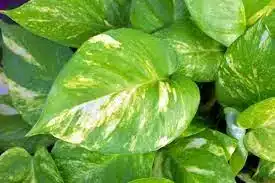Ecological Succession
- The process by which communities of plant and animal species in an area are replaced or changed into another over a period of time is known as ecological succession.
- Succession is a universal process of directional change in vegetation, on an ecological time scale.
- Succession occurs due to large scale changes or destruction (natural or manmade).
- The process involves a progressive series of changes with one community replacing another until a stable, mature, climax community develops.
Stages of Ecological Succession
- The first plant to colonize an area is called the pioneer community.
- The final stage of succession is called the climax community.
- A climax community is stable, mature, more complex and long-lasting.
- The stage leading to the climax community is called successional stages or seres.
- Each transitional community that is formed and replaced during succession is called a stage in succession or a seral community.
- Succession is characterized by the following: increased productivity, the shift of nutrients from the reservoirs, increased diversity of organisms, and a gradual increase in the complexity of food webs.
- Succession would occur faster in area existing in the middle of the large continent. This is because here seeds of plants belonging to the different seres would reach much faster.
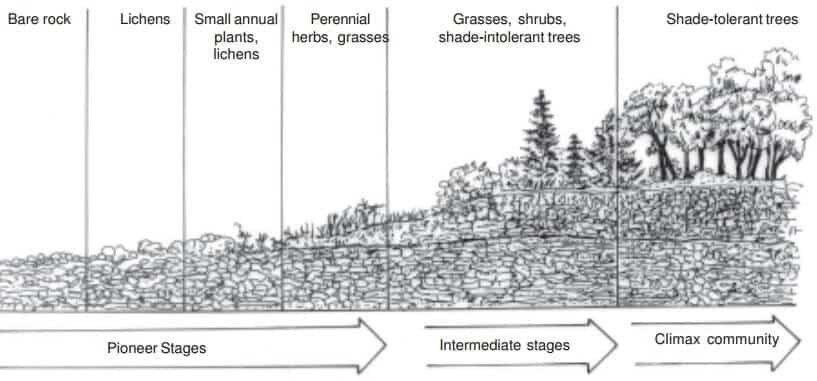
Types of Ecological Succession
Primary Succession: Ecological Succession
- Primary succession takes place an over where no community has existed previously.
- Such areas include rock outcrops, newly formed deltas and sand dunes, emerging volcano islands and lava flows, glacial moraines (muddy area exposed by a retreating glacier), etc.
- In primary succession on a terrestrial site, the new site is first colonised by a few hardy pioneer species that are often microbes, lichens and mosses.
- The pioneers over a few generations alter the habitat conditions by their growth and development.
- The pioneers through their death any decay leave patches of organic matter in which small animals can live.
- The organic matter produced by these pioneer species produce organic acids during decomposition that dissolve and etch the substratum releasing nutrients to the substratum.
- Organic debris accumulates in pockets and crevices, providing soil in which seeds can become lodged and grow.
- The new conditions may be conducive to the establishment of additional organisms that may subsequently arrive at the site.
- As the community of organisms continues to develop, it becomes more diverse, and competition increases, but at the same time, new niche opportunities develop.
- The pioneer species disappear as the habitat conditions change and invasion of new species progresses, leading to the replacement of the preceding community.
Secondary Succession: Ecological Succession
Secondary succession is the sequential development of biotic communities after the complete or partial destruction of the existing community. Example: where wildfires have destroyed conifer forests, or where former agricultural land is reverting to meadow or scrubland.
- A mature or intermediate community may be destroyed by natural events such as floods, droughts, fires, or storms or by human interventions such as deforestation, agriculture, overgrazing, etc.
- This abandoned land is first invaded by hardy species of grasses that can survive in bare, sun-baked soil.
- These grasses may be soon joined by tall grasses and herbaceous plants. These dominate the ecosystem for some years along with mice, rabbits, insects and seed-eating birds.
- Eventually, some trees come up in this area, seeds of which may be brought by wind or animals.
- And over the years, a forest community develops. Thus, an abandoned land over a period becomes dominated by trees and is transformed into a forest.
Autogenic and Allogenic Succession: Ecological Succession
- When succession is brought about by living inhabitants of that community itself, the process is called autogenic succession, while change brought about by outside forces is known as allogenic succession.
- Autogenic succession is driven by the biotic components of an ecosystem.
- Allogenic succession is driven by the abiotic components (fire, flood) of the ecosystem.
Autotrophic and Heterotrophic succession: Ecological Succession
- Succession in which, initially the green plants are much greater in quantity is known as autotrophic succession; and the ones in which the heterotrophs are greater in quantity is known as heterotrophic succession.
Difference Between Primary and Secondary Succession
- Unlike in the primary succession, the secondary succession starts on a well-developed soil already formed at the site. Thus, secondary succession is relatively faster.
Succession in Plants
- Succession that occurs on land (dry areas) where moisture content is low for e.g. on a bare rock is known as xerarch.
- Succession that takes place in a water body, like ponds or lake is called hydrarch.
- Both hydrarch and xerarch successions lead to medium water conditions (mesic) – neither too dry (xeric) nor too wet (hydric).
- With time the xerophytic habitat gets converted into a mesophyte (plat needing only a moderate amount of water).
Succession in Water
- In primary succession in water, the pioneers are the small phytoplankton, and they are replaced with time by free-floating angiosperms, then by rooted hydrophytes, sedges, grasses and finally the trees.
- The climax again would be a forest. With time the water body is converted into land.
- Another important fact is to understand that all succession whether taking place in water or on land, proceeds to a similar climax community – the mesic.
Also refer :

